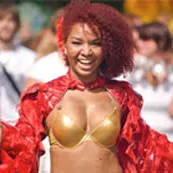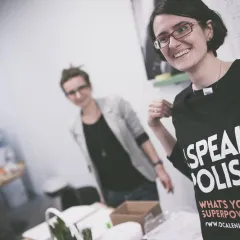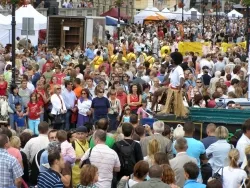‘'Why are you so amused?’ I asked.
‘In Cracow they say that your Old Town is made of plastic!’ Their Senegalese ancestors didn’t even know who Sigismund III Vasa was. However, they bore a grudge against him.
‘If it hadn’t been for this king, who has the oldest secular monument in Poland, we would study in the capital city of Cracow. But now we study “only” in the former capital. Too bad!’ they were joking. Knowing animosities between Cracow and Warsaw, I began to wonder about the name of a certain street. Krakowskie Przedmieście (Cracow Suburb Street). One of the most representative street in Warsaw. I decided to find out more about this street. Its present name comes from Cracow, to which the Royal Route led. Every inhabitant of Warsaw (not necessarily native, you only need to live here) knows that the Royal Route runs from the Castle Square and then transforms gently into another street - Nowy Świat (New World). Although the Nicolaus Copernicus Monument clearly marks the boundary.
Does keeping this name denote the love to Cracow or to tradition only? It was like that in the past so let it be. I lived in Powiśle for many years, behind the University. I often strolled along Krakowskie Przedmieście. What did this street look like in the old times? What happened there in the past?
In the middle of the 18th century the street was already cobbled and by the mid-19th century gas lightning was installed. Krakowskie Przedmieście has always been a witness of demonstrations, especially during the partitions of the country. The street became the representative artery of the city with the best shops and the most notable people walking there. In 1907 electric lighting and electric trams appeared. During Hitler’s occupation the route was called Krakauer Strasse. Even the Germans felt respect and instead of changing the name they translated it.
The street was also a place of students’ demonstration in 1968 (it was also an intense period at one of the universities in Dakar in my Senegal) as well as a place where John Paul II met with the youth in 1979 (in front of St. Anne's Church).
After renovation, Krakowskie Przedmieście became a wide pedestrian zone with a street in the middle which is available only for public transport and taxis. New, stylized benches and bollards, flowerbeds, crosier-like street lamps appeared, dozens of trees were planted and four glass cubes with Canaletto’s reproductions were put. Zamontowano nowe, nieingerujące w zabytkowe otoczenie wiaty przystankowe.
New bus stop shelters don’t disturb the historical surroundings. Also, there are awsome kiosks, not to mention ”discrete” bus stops. All ideas couldn’t be realized – eventually, an artificial stream at Hoover Square didn’t come into existence.
In this exact spot, just next to Adam Mickiewicz monument, an international Africa Day will take place at the end of May. The musicians from Voo Voo band and African artists from Warsaw will invite Cracovian diaspora. My compatriots will come for sure and they will see how the street named after the former capital is teeming with life. How beautifully it reflects the old-time atmosphere and at the same time beams with modernity. It definitely doesn’t smell of plastic. They should see countless pubs, clubs, restaurants. Today, a coffeehouse is a “cafe”.
Cafe Trakt, Cafe Telimena, Pub Indeks just next to the gate of the University of Warsaw (former Giovanni), Cafe Plotka near Prus Bookshop (I’ve left there a fortune), Cafe Bez Kantów in a building named exactly the same, cafe Pożegnanie z Afryką (Farewell to Africa), Bistro Kebab (they say that it’s a restaurant for the poor) and many other places seen or hidden. What a great deal of tourist attractions! Churches, palaces (including Presidential Palace), monuments... Would an ugly street have the Academy of Fine Arts? Is there a wiser street with a university and the Polish Academy of Sciences? Walking today is a pure pleasure. Clean and beautiful. New, stylized benches, flowers, street lamps and so inspiring historical surroundings. I miss the summer weekends already. When Krakowskie Przedmieście becomes a promenade with no buses or taxis. Only baby prams and bikes remind us that wheels rule here during the week(but only in a restricted traffic zone). I’ve read that in the 18th century the name Wide Krakowskie Przedmieście came into use. The first decade of the 21st century has passed. It’s good that Krakowskie Przedmieście is wide again.
Suddenly a melody comes to me, it’s being born right now. In my mind. Specially for my compatriots from Kraków. I feel an urge to sing out loud so that the whole street would here:
Poland grows beautiful today
because Krakowskie is smiling,
not a city on the Vistula
but a street in the heart of Warsaw.
because Krakowskie is smiling,
not a city on the Vistula
but a street in the heart of Warsaw.
Mamadou Diouf
Translated by: Iwona Białek

















